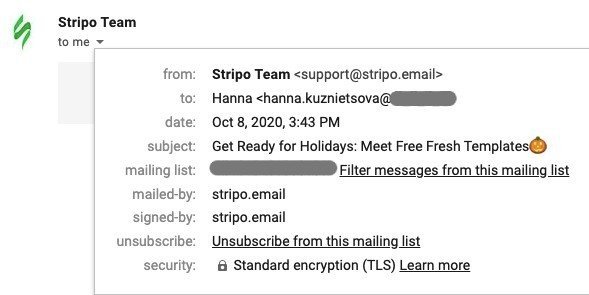What is an email header? What does it contain? And why is it so important to understand how to work with it? We will give answers to these questions here.
The emails header is a part of your email that consists of three parts:
-
info about sender and recipient;
-
the subject line, and preheader;
-
email header itself (as component of HTML email that customers see).

(Email header as visual component of HTML email)
In this article, we will talk about part 1 — info about sender and recipient (we will refer to it as Email header).
For more information about parts 2 and 3 and for more email header examples and design ideas, please refer to our “Email header” blog post.
What is an email header?
Email header is considered a piece of your HTML email code that includes data about the sender and the recipient, email route, and a variety of authentication specifications.
Role of email header
-
Showing information about the sender and recipient.
-
Preventing your emails from going to the Spam folder.
-
Email route identification.
1. Showing information about the sender and recipient
An Email message header indicates those who sent the email and those who received it. For example, the "From" line displays the sender's email address and name, while “To” reveals the same information about a recipient. The "Date" is about time and sending date. Other elements include non-binding data and their presence depends among email service providers terms.

2. Preventing your emails from going to the Spam folder
Email clients eliminate the possible spam problems via information shown in the email header. Email clients analyze the header, particularly the “Received:” Tag to make a decision of whether to deliver the email to the user's inbox or the Spam folder.
3. Email route identification
The email transition process goes through the Mail Transfer Agent which "marks" the email with some recipient's data, time, and date in the email header.
What fields are contained in the email header?
Or, what are email headers aspects in a deeper view? There are much more elements contained in the email header besides name, email address, time and date of sending. Let's sort out what a full email header indicates:
-
from;
-
to;
-
date;
-
subject (aka subject line);
-
return-path (reply-to);
-
domain Key and DKIM Signatures;
-
message-ID;
-
MIME-Version;
-
received;
-
X-Spam status.
Here is an in-depth overview of each of the above points:
1. From
This field in the email header displays the name and email address of the sender.
2. To
The field named "To" includes information about a receiver. You can find the CC (carbon copy) and BCC (blind carbon copy) sections there, as well.
3. Date
Here you can see the day of the week, date, month, year, and time when an email was sent.
Generally, its form is “day dd month yyyy hh:mm:ss.”, for instance: Tue, 30 Nov 2021 5:30:59 PM.
4. Subject (Subject line)
An email header information has the subject line of your email that sums up everything that you put inside your email body.
5. Return-Path (Reply-to)
The second name of this folder is Reply-To. Replying to the “reply-to” email address, users make sure the response will be delivered to the address specified in the Return-Path line.
6. Domain Key and DKIM Signatures
Being the same signatures as SPF ones, the Domain Key and Domain Key Identified Mail (DKIM) are used by service providers for identifying and authenticating your emails. This parameters tells email clients who exactly sent this email and if the sender is trustworthy. Remember, we mentioned that email header prevents your emails from going to Spam.
7. Message-ID
This is a certain number of letters and figures that are set for each email and will never be used in other ones.
8. MIME-Version
Another section of an email header html is Multipurpose Internet Mail Extensions or (MIME). Its role is to transform the content that does not include text such as pictures and video files into text format. Thus, they get a possibility to be attached to the email and sent via SMTP (Simple Mail Transfer Protocol).
9. Received
In this folder, you may find all mail servers listed that the email has passed on the way to the inbox. It's shown in reverse order. The upper mail server is the last one the email passed through. At the same time, the lower server is where the email was directed.
10. X-Spam Status
It expresses the spam score of the email. Firstly, it shows you if the email was considered spam at all. If so, it makes you know what spam score your email has and spam threshold.
Your email could go beyond the spam threshold or comply with the norms. However, if it is defined as spam it will be sent to the corresponding folder.


